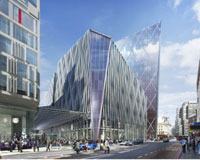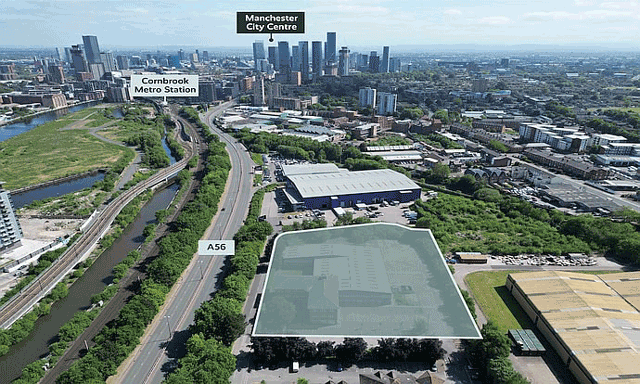The grey canyon of Victoria Street, at the heart of the West End district from which it takes its name, leaves its mark on all unsuspecting visitors. As home to Britain’s political and ecclesiastical apparatus, no one could argue with the area’s importance, but it is undeniably austere.
However, pre-credit crunch, Victoria started to emerge as an overspill area for the more established West End office locations. Microsoft followed its compatriot tech giant Google into the area in 2006, following the completion of Land Securities’ 650,000 sq ft Cardinal Place scheme, and some swanky residential schemes created a previously unknown vibrancy.
With LandSec and Terrace Hill both completing major mixed-use schemes this year, its proponents claim it is Victoria’s time again. But can it genuinely overcome its Presbyterian demeanour, traffic congestion and the lack of amenity, often cited as its Achilles Heel? Is there genuine depth to its much-vaunted ascendency or simply vested hyperbole?
Design agency Bostock & Pollitt recently authored the London Street by Street: Victoria Street survey, which focuses on the areas driving London’s transformation. Tellingly, Victoria Street and its £1bn-plus transformation is the first in this series. It highlights an image problem and the need for a co-ordinated approach in tackling this.
Kickstarting the next phase
Schemes such as Terrace Hill’s and Doughty Hanson’s 142,000 sq ft Howick Place office and residential development, LandSec’s 123 Victoria, comprising 227,500 of offices and retail, as well as its 59 luxury apartment scheme, Wellington House, will kickstart the next phase when they all complete this year.
LandSec, more than any other developer, is invested in Victoria. Between now and 2018, it proposes to deliver more than 1.2m sq ft of offices, almost 200,000 sq ft of retail and 331 flats in Victoria – not including the 317,500 sq ft Portland House residential conversion, for which it will submit planning in the coming financial year.
Its 5.5-acre Victoria Circle joint venture with the Canada Pension Plan Investment Board is touted as the linchpin of the area’s renewal with more than 1m sq ft of prime offices, residential, and retail being delivered over the next six years.
Architect PLP co-authored the Victoria Transport Interchange 2 masterplan, as it was then known, which was the largest single consent when Westminster council approved planning in 2009. President Lee Polisano says: “I see Victoria Circle as an enabler for further changes to this part of the city. It will mark the completion of the first stage of a greater masterplan for the area that we have been planning for a number of years. It will lead to a fundamental rethink of what people will do with the rest of Victoria.”
There is an enormous amount of infrastructure underground and Polisano maintains it could not be incrementally developed by single landlords. “Victoria Circle could never happen if the site was under separate ownership,” he claims.
This assertion has a ring of truth, given the consensus of opinion that the area can be transformed only by a concerted and co-ordinated approach.
Westminster council’s recently updated planning brief for Victoria now takes in Parliament Square to the west, with potential for the Queen Elizabeth II Conference Centre to become a development site. The idea is to transform it from simply a commuter location to serve a growing commercial and affluent residential population.
“We hold the rig between TfL, London Underground and others, and are keeping up the pressure so that real timetables for development are achieved. Otherwise, we could lose out on the opportunity,” says Rosemarie MacQueen, strategic director for built environment at Westminster council.
Sewers, telecoms and other vital infrastructure are being rebuilt, and Westminster has completed the first major compulsory purchase order to unlock LandSec’s Victoria Circle scheme.
Fir for purpose
What is being creating in Victoria over the next five to 10 years is fit-for-purpose, large-floorplate buildings at rents favourable to its neighbours. “We won’t catch up with those surrounding areas quite yet,” says LandSec’s residential director, Tom Eshelby. “But it will not be just a cheap alternative; it will be a good comparison.”
However, that vision could be impaired by Google’s decision not to renew its lease at 123 Buckingham Palace Road. It is negotiating to take space at Argent’s King’s Cross scheme. Microsoft is also looking for a new 75,000 sq ft HQ, so a move from Cardinal Place is possible.
Irrespective of the potential loss of these high-profile occupiers, agents point to luxury brands Burberry and Jimmy Choo preletting all of Derwent’s 127,000 sq ft 1 Page Street and taking 37,000 sq ft at LandSec’s 123 Victoria Street, respectively. Or oil giant PetroChina taking two floors at Heron International’s The Peak, for that matter.
Andy Tyler, partner at Cushman & Wakefield’s West End agency, says: “Chapter one was five years ago, with Cardinal Place and Belgrave House, as well as Victoria Plaza where the Telegraph is headquartered. Chapter two is right now, and chapter three is Land Securities’ plans for Kingsgate House and Victoria Circle.”











